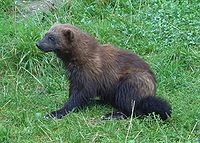
Photo from wikipedia
Aim In the mid-20th century, many populations of large-bodied mammals experienced declines throughout North America. Fortunately, within the last several decades, some have begun to rebound and even recolonize extirpated… Click to show full abstract
Aim In the mid-20th century, many populations of large-bodied mammals experienced declines throughout North America. Fortunately, within the last several decades, some have begun to rebound and even recolonize extirpated portions of their native range, including black bears (Ursus americanus) in the montane areas of the western Great Basin. In this study, we examine genetic variation in source and recolonized areas to better understand the genetic consequences of recolonization. Location Western Great Basin, USA. Methods Using multiple loci, we characterized genetic variation among source and recently recolonized areas occupied by black bears, tested for population structure and applied approximate Bayesian computation to test competing hypotheses of demographic history. We assessed signals of gene flow using expectations of genetic consequences derived from alternative modes of recolonization (bottleneck, metapopulation, island model) and tested for significant signals of genetic bottlenecks in areas recently recolonized by black bears. Results As anticipated from field survey data and hypothesized expectations, genetic variation of western Great Basin black bears retain an overall signature of demographic decline followed by recent rebound. Furthermore, results reveal that bears in the recolonized range are minimally differentiated from the source area, but newly established subpopulations have lower effective population sizes and reduced allelic diversity. Nevertheless, recolonized areas fail to show a significant signal of a genetic bottleneck. Moreover, bears occupying recolonized areas experience asymmetric gene flow, yielding strong support for a model of genetic connectivity that is best described as a metapopulation. Main Conclusion This study presents one of the few empirical examples of genetic consequences of natural recolonization in large-bodied mammals. Furthermore, these results have implications for understanding the complexities associated with the genetic consequences of recent and ongoing recolonization and highlight the need to develop management strategies uniquely tailored to support connectivity between source and recolonized areas.
Journal Title: Diversity and Distributions
Year Published: 2018
Link to full text (if available)
Share on Social Media: Sign Up to like & get
recommendations!